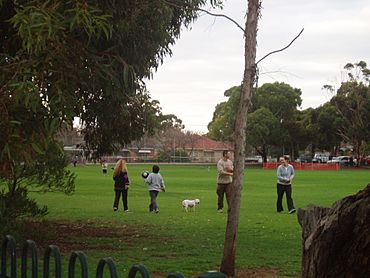Glengowrie, South Australia facts for kids
Quick facts for kids GlengowrieAdelaide, South Australia |
|||||||||||||||
|---|---|---|---|---|---|---|---|---|---|---|---|---|---|---|---|

Hazelmere Reserve on the south-eastern boundary of Glengowrie
|
|||||||||||||||
| Postcode(s) | 5044 | ||||||||||||||
| Area | 1.9 km2 (0.7 sq mi) | ||||||||||||||
| LGA(s) | City of Marion | ||||||||||||||
| State electorate(s) | Morphett | ||||||||||||||
| Federal Division(s) | Boothby | ||||||||||||||
|
|||||||||||||||
Glengowrie is a suburb in the city of Adelaide, Australia. It's about 12 kilometres (7.5 miles) southwest of the city centre. The name Glengowrie means "Glen of Gowrie." It was named to honour Lord Gowrie. He was the Governor-General of Australia from 1936 to 1944.
Contents
Where is Glengowrie?
Glengowrie is located in the City of Marion. It has clear boundaries that help you find it. To the north, you'll find the Glenelg tram line. Morphett Road is on its eastern side. Oaklands Road marks its southern edge. The western side is bordered by parts of Diagonal Road, Panton Crescent, and Buttrose Street.
The western part of Glengowrie is very close to the beach. It's only about 2 kilometres (1.2 miles) from the famous beaches of Glenelg. Glenelg is one of Adelaide's most popular beach areas.
How Glengowrie Started
Glengowrie began as a new housing area in 1936. It was advertised as "the New Centenary Suburb." This was because 1936 was 100 years after the Colony of South Australia was founded in 1836.
At first, the new area had only four streets. These were Maxwell Terrace (where the tram line is), Butler Crescent, Winston Crescent, and Fisk Avenue. Before this, the land belonged to a well-known farming family called Hawker. In 1940, the suburb grew bigger. Glengowrie covers an area of 1.9 square kilometres (0.73 square miles).
Who Lives in Glengowrie?
In 2021, about 5,767 people lived in Glengowrie. A little more than half of them (53.3%) were female. About 20% of the people living there were born outside Australia. The largest groups came from England, South Africa, Scotland, India, and New Zealand.
Many people in Glengowrie speak English at home. However, other languages are also spoken. These include Greek, Mandarin, Spanish, Italian, and Hindi.
There are many types of homes in Glengowrie. Most are separate houses. There are also many semi-detached homes and some flats or apartments. Many homes are fully owned by the people living in them. Others are owned with a mortgage, or they are rented. The average weekly income for households in Glengowrie is higher than the average for Adelaide.
How Glengowrie is Governed
Glengowrie is managed by the local council called the City of Marion. This council helps make decisions about local services. These services include parks, roads, and rubbish collection.
For state government elections, Glengowrie is part of the Morphett area. For federal government elections, it is in the division of Hindmarsh.
Fun Places and Things to Do
Glengowrie has several interesting places and facilities for its residents.
Hazelmere Reserve and Dog Park
The Hazelmere Reserve is a public park on the southern edge of Glengowrie. It has a very popular fenced area known as the "Dog Park." This park is often full of dogs and their owners, especially in the late afternoon and on weekends. The reserve is built on the old oval of the former Glengowrie High School.
Glengowrie Tram Depot
The Glengowrie Tram Depot is where the trams are kept. These trams started running in 1927. They serve Adelaide's only remaining tram line, which goes from Adelaide city to Glenelg beach.
Sturt River Linear Park
The Sturt River Linear Park is a walking and cycling trail. It follows the Sturt River through the southwestern part of Adelaide. The trail goes from Marion all the way to Glenelg. A small part of this park crosses through the northeastern tip of Glengowrie. You can find it near the Glenelg East Reserve off Fisk Avenue.
Glengowrie High School History
Glengowrie High School first opened its doors in 1969. However, it closed down in 1991. The students and staff joined with Mitchell Park High School to form Hamilton Secondary College. The land where the high school used to be is now home to the Glengowrie Retirement Estate and the Hazelmere Reserve.

